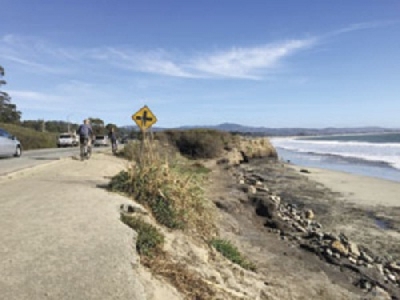
Posted on June 12, 2018
By Carina Woudenberg, Half Moon Bay Review
There is progress on a pilot beach replenishment project slated for Surfer’s Beach, but don’t expect to see any movement of sand until summer of 2019.
Pillar Point Harbor has been plagued with erosion issues since the east breakwater was completed in 1961. The barrier disrupted the natural flow of sand, which piled up on the harbor side and led to the depletion of beach adjacent to it. Surfers and other beachgoers mourned the loss of sand. Without that sand buffer, erosion increased to an average rate of 1.64 feet per year along Surfer’s Beach, according to the U.S. Army Corps of Engineers
Dramatic erosion rates along Mirada Road in Miramar have been blamed, too, on the placement of the breakwater.
Though it has concluded its breakwater design is responsible, the Army Corps of Engineers determined that there was no federal interest in a beach nourishment project, as Highway 1 would be protected by other means.
In response, the San Mateo County Harbor District began pursuing its own pilot project in late 2015. Funding for the project has mostly been established through the award of two grants.
A $75,000 grant from the Ocean Protection Council is slated for project planning. While another $800,000 from the California Division of Boating and Waterways is intended to cover the construction and monitoring involved in the project.
At the May 16 Harbor Commission meeting, the district’s five commissioners voted unanimously to accept the money. As part of that approval, the district is responsible for a 15 percent cost match for the project, which would amount to $120,000. The money can be paid in cash or in in-kind services that may be covered through the district’s work into the project.
The district plans to continue to look for additional funding opportunities, according to a recent staff report.
Brad Damitz, a consultant hired by the district to handle funding and other organizational aspects of the pilot project, gave a presentation updating commissioners on where the project stood. In the presentation, Damitz highlighted the progress made toward communication with various permitting agencies. The pilot project will involve moving 75,000 cubic yards of sand — enough sand to fill the Goodyear blimp 10 times — from the north side of the breakwater to the south. This is a significantly smaller load than most full-scale beach replenishment projects, Damitz noted, but one necessary for testing the waters, so to speak.
“Nothing like this has ever been done in a national marine sanctuary,” Damitz said at the meeting, adding that the delicacy of the area led to issues with permitting as well as the inability to launch into a larger project.
“It’s a pilot because we want to learn where that sand moves, whether its effective, does it have any impacts on the local animals that inhabit the beach?” he said.
Next month, representatives from the U.S. Geological Survey will be out in the area to collect data that will lend further insight to the project.
They’ll be venturing out on Jet Skis equipped with a variety of survey equipment that will allow them to measure the depth of the area so that the Army Corps can plug into its models, Damitz said.
The Harbor District is also looking into establishing a program that would assess sand surpluses and deficits in other areas in and around the Harbor District as well as multi-year permits that could streamline these efforts.
Source: Half Moon Bay Review





